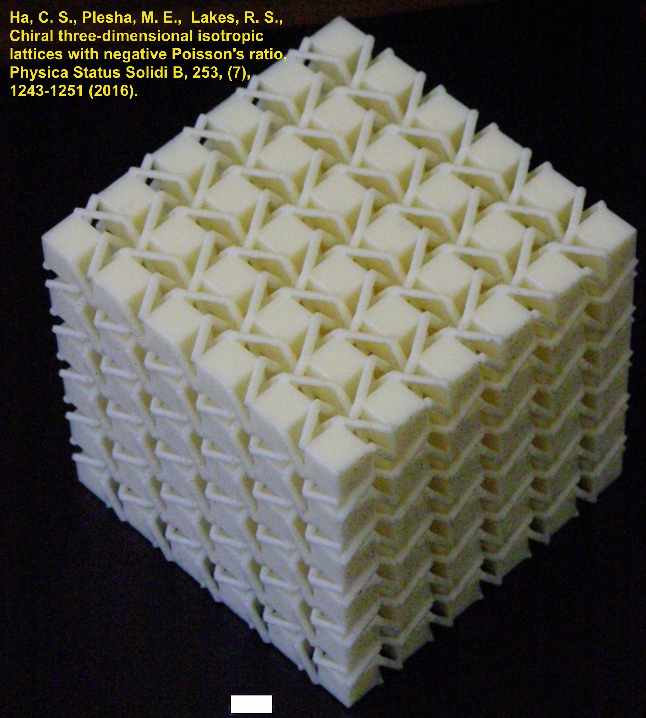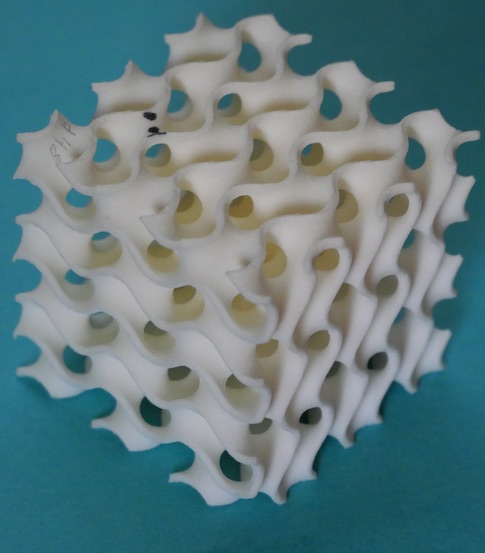|
Background Columbia University, Mathematics Rensselaer Polytechnic Institute, B.S.; Ph.D. Yale University, Research Associate. Research group, collaborators and laboratory Publication list Books Case studies for class aircraft safety, bio-med Humor: error message haiku. |


Viscoelasticity 
Chiral Cosserat |

New materials |
Book: R. S. Lakes, Composites and Metamaterials, (2020).
Book outline
Research summary
In our laboratory we conceptualize, synthesize and characterize materials with extreme and unusual physical properties. Recently such materials have been called metamaterials.
We have developed new materials with reversed properties, including the first 3D materials with a negative Poisson's ratio (auxetic). More recently we have made related materials using 3D printing.
We have developed the first materials with arbitrarily large magnitudes of positive or negative thermal expansion. Zero thermal expansion is also attainable.
We have developed the first extreme materials based on negative stiffness inclusions in composites. Recently such materials have been called metamaterials. Recently such materials with an internal source of energy or power have been called active materials.
Materials which undergo phase transformation are of interest in the context of viscoelastic damping and of negative stiffness. The first uses of negative stiffness to achieve extreme properties were demonstrated in our lab. Composite materials stiffer than diamond over a temperature range have been studied experimentally. These are also called metamaterials.
We investigate the freedom of natural and synthesized materials to behave in ways not anticipated in elementary continuum representations, to ameliorate stress concentrations, and to attain physical properties of much higher magnitude than anticipated from standard theories. Designed Cosserat (micropolar) solids have been made by 3D printing. These materials exhibit reduced stress concentrations compared with classical elastic materials.
The first experimental determination of the full set of Cosserat elastic constants for a material was done in our laboratory. We are currently conducting holographic experimental study of nonclassical bending deformation in foams and lattices.
The first designed 2D chiral elastic material was made in our laboratory and also the first 3D designed and 3D printed Cosserat chiral elastic material. These have been called chiral metamaterials. We have observed effects of nonclassical chiral elasticity in the gyroid lattice. The theoretical basis for interpreting such experiments was developed in our research.
was made in our laboratory and also the first 3D designed and 3D printed Cosserat chiral elastic material. These have been called chiral metamaterials. We have observed effects of nonclassical chiral elasticity in the gyroid lattice. The theoretical basis for interpreting such experiments was developed in our research.
We study materials with heterogeneous structure, including natural viscoelastic composites such as bone, ligament, tendon and wood; also synthetic composites, biomaterials, and cellular solids with structural hierarchy. Viscoelastic materials are of particular interest as high performance damping materials and as practical materials which undergo creep in industrial settings. We determine viscoelastic properties including internal friction, dependence on strain rate, and creep over eleven orders of magnitude of frequency and time, with no need for temperature shifts. We have developed materials and structures that offer extreme viscoelastic damping: the figure of merit far exceeds that of commercial polymer damping layers.
We also study practical rib lattices as well as composite materials such as dental composites for tooth restorations and aircraft composites in the context of damage resistance and damage tolerance as well as moisture ingression. Piezoelectric composites and lattices, chiral elastic lattices, as well as thermoelastic composites and lattices are presently of particular current interest. We pursue basic research as well as applied research for industry. Industrial research has included high temperature performance studies of alloys for small engines, improved shoe insoles, advanced metamaterial lattices and advanced dampers.
From July 2023 through 2025, we are conducting study of advanced heterogeneous materials with extreme properties that exceed the usual bounds on physical properties. Nonclassical effects, chirality, and asymmetry of tensors are of particular interest as odd properties. In that context, we are considering the tensorial rank of physical properties. We are also studying optical measurement of nonclassical effects in rib lattices. For 2026, we plan further study of tensor properties as well as wood and biomaterials.
A recent article, R. S. Lakes, Materials that exceed classical thermodynamic bounds on properties, Reviews of Modern Physics, 97, 021002 14 May, (2025). journal link doi journal link reprint pdf
Research summary
In our laboratory we conceptualize, synthesize and characterize materials with extreme and unusual physical properties. Recently such materials have been called metamaterials.
We have developed new materials with reversed properties, including the first 3D materials with a negative Poisson's ratio (auxetic). More recently we have made related materials using 3D printing.
We have developed the first materials with arbitrarily large magnitudes of positive or negative thermal expansion. Zero thermal expansion is also attainable.
We have developed the first extreme materials based on negative stiffness inclusions in composites. Recently such materials have been called metamaterials. Recently such materials with an internal source of energy or power have been called active materials.
Materials which undergo phase transformation are of interest in the context of viscoelastic damping and of negative stiffness. The first uses of negative stiffness to achieve extreme properties were demonstrated in our lab. Composite materials stiffer than diamond over a temperature range have been studied experimentally. These are also called metamaterials.
We investigate the freedom of natural and synthesized materials to behave in ways not anticipated in elementary continuum representations, to ameliorate stress concentrations, and to attain physical properties of much higher magnitude than anticipated from standard theories. Designed Cosserat (micropolar) solids have been made by 3D printing. These materials exhibit reduced stress concentrations compared with classical elastic materials.
The first experimental determination of the full set of Cosserat elastic constants for a material was done in our laboratory. We are currently conducting holographic experimental study of nonclassical bending deformation in foams and lattices.
The first designed 2D chiral elastic material
 was made in our laboratory and also the first 3D designed and 3D printed Cosserat chiral elastic material. These have been called chiral metamaterials. We have observed effects of nonclassical chiral elasticity in the gyroid lattice. The theoretical basis for interpreting such experiments was developed in our research.
was made in our laboratory and also the first 3D designed and 3D printed Cosserat chiral elastic material. These have been called chiral metamaterials. We have observed effects of nonclassical chiral elasticity in the gyroid lattice. The theoretical basis for interpreting such experiments was developed in our research.
We study materials with heterogeneous structure, including natural viscoelastic composites such as bone, ligament, tendon and wood; also synthetic composites, biomaterials, and cellular solids with structural hierarchy. Viscoelastic materials are of particular interest as high performance damping materials and as practical materials which undergo creep in industrial settings. We determine viscoelastic properties including internal friction, dependence on strain rate, and creep over eleven orders of magnitude of frequency and time, with no need for temperature shifts. We have developed materials and structures that offer extreme viscoelastic damping: the figure of merit far exceeds that of commercial polymer damping layers.
We also study practical rib lattices as well as composite materials such as dental composites for tooth restorations and aircraft composites in the context of damage resistance and damage tolerance as well as moisture ingression. Piezoelectric composites and lattices, chiral elastic lattices, as well as thermoelastic composites and lattices are presently of particular current interest. We pursue basic research as well as applied research for industry. Industrial research has included high temperature performance studies of alloys for small engines, improved shoe insoles, advanced metamaterial lattices and advanced dampers.
From July 2023 through 2025, we are conducting study of advanced heterogeneous materials with extreme properties that exceed the usual bounds on physical properties. Nonclassical effects, chirality, and asymmetry of tensors are of particular interest as odd properties. In that context, we are considering the tensorial rank of physical properties. We are also studying optical measurement of nonclassical effects in rib lattices. For 2026, we plan further study of tensor properties as well as wood and biomaterials.
A recent article, R. S. Lakes, Materials that exceed classical thermodynamic bounds on properties, Reviews of Modern Physics, 97, 021002 14 May, (2025). journal link doi journal link reprint pdf

